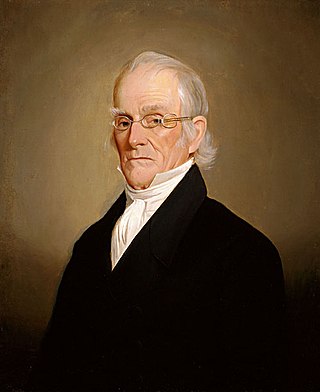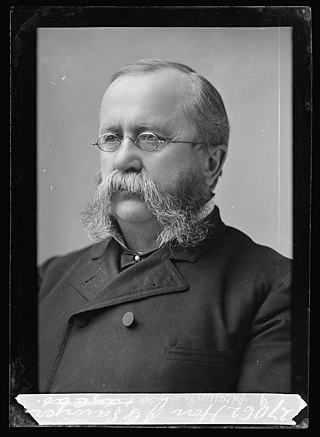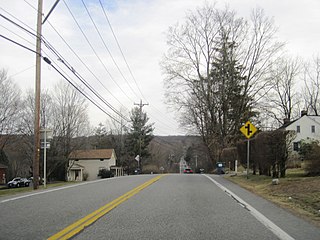
Orleans County is a county in the western part of the U.S. state of New York. As of the 2020 census, the population was 40,343. The county seat is Albion. The county received its name at the insistence of Nehemiah Ingersoll though historians are unsure how the name was selected. The two competing theories are that it was named to honor the French Royal House of Orleans or that it was to honor Andrew Jackson's victory in New Orleans.

Nathaniel Rochester was an American Revolutionary War soldier and land speculator, most noted for founding the settlement which would become Rochester, New York.

New York State Route 269 (NY 269) is a north–south state highway located in western New York in the United States. The highway runs for 6.36 miles (10.24 km) along the Niagara–Orleans county line and is named County Line Road. The southern terminus of NY 269 is at an intersection with NY 104 in the hamlet of Jeddo. Its northern terminus is at a junction with NY 18 in the hamlet of County Line. NY 269 is one of only two state highways in New York that are located wholly along a county boundary; the other is NY 272 on the other side of Orleans County. The route was assigned as part of the 1930 renumbering of state highways in New York and has not been altered since.
Fancher is a hamlet in the town of Murray in Orleans County, New York, United States. The ZIP Code for Fancher is 14452. It is named after Edward Fernando Fancher, a native of Durham in Greene County, New York. Fancher was a minister and farmer who first settled in Carlton and then in Gaines before relocating to Murray. In 1887 he partnered with Charles F. Gwynne in the quarrying of Medina Sandstone. The following year he opened his own quarry on land purchased near Hulberton. After the establishment of a post office, the small settlement was named in Fancher's honor due to the massive quantity of sandstone shipped from the location by way of the Erie Canal and New York Central Railroad. Fancher served as the general manager of the Orleans County Quarry Company and was one of the more prominent quarry owners in Orleans County.

Elizur Kirke Hart was an American banker and politician who served one term as a U.S. Representative from New York from 1877 to 1879.

John Gilbert Sawyer was a U.S. Representative from New York.
Millville is a hamlet in the town of Shelby in Orleans County, New York, United States.

Bellvale is a wooded hamlet in the town of Warwick in Orange County, New York, United States. Situated in the morning shadow of Bellvale Mountain along New York State Route 17A, Bellvale was the site of an iron forge destroyed by British Army soldiers in 1750; many of its homes and other structures date from before American independence. While close to New York City, its location in the Warwick Valley has prevented suburban development.
Dan Hyde Cole was an American lawyer and politician from New York.
Hulberton is a hamlet in the town of Murray in Orleans County, New York, United States. It is named after Isaac Henry Scott Hulbert, a native of Pittsfield in Berkshire County, Massachusetts. Arriving first at Sandy Creek in 1824, Hulbert soon relocated the following year to the nearby hamlet of Scio. The location prospered along the Erie Canal where Hulbert engaged in the produce business. On March 6, 1830 he was selected at chairman of the building committee for the Methodist Episcopal Church and was a long-time Justice of the Peace.
Brockville is a hamlet in the town of Murray in Orleans County, New York, United States. It is named after Heil Brockway, a native of Clinton in Middlesex County, Connecticut, United States. The small settlement is located approximately 0.75 miles east of Hindsburg and was largely settled due to the opening of Medina Sandstone quarries in that vicinity.
Kenyonville is a hamlet in Orleans County, New York, United States. It is named after Barber Kenyon, a native of East Greenwich in Washington County, who first settled in that location, erecting a grist mill and saw mill. The community is located along the Oak Orchard Creek, 2.3 miles (3.7 km) north of the historic Ridge Road. In 1894, the community consisted of a post office, store, blacksmith shop, wagon shop, grist mill, saw mill, and a Methodist church.
Sawyer is a hamlet in the town of Carlton, Orleans County, New York, United States. It is named after John G. Sawyer, a congressman from New York. The settlement was previously named "Curtis's Corners" after John Curtis, a native of New Hampshire, who settled on lot 1, section 5 at Carlton in Orleans County. In 1894 the hamlet contained a store, post office, and blacksmith shop.

Eagle Mills Township is a rural, non-functioning subdivision of Iredell County, North Carolina, United States. By the requirements of the North Carolina Constitution of 1868, the counties were divided into townships, which included Eagle Mills. Eagle Mills Township was named for the town of Eagle Mills, which was established by Andrew Baggerly on Hunting Creek in 1848.
Eagle Harbor is a hamlet in the town of Gaines, in Orleans County, New York, United States. It was said to have been named due to the discovery of a large bird's nest, presumably an eagle's nest, when the Erie Canal was surveyed. A clearing was made by Steven Abbott circa 1811-12, but the location did not experience significant growth until the construction of the Canal. In 1894, the village contained three general stores, a hotel, and livery stable, a barrel factory, two blacksmiths, a wagon shop, a church and washing machine factory, meat market, grist mill, warehouse, two churches, two schools, and approximately 350 inhabitants.
East Gaines is a hamlet in the town of Gaines in Orleans County, New York, United States. In 1826, Peter Runion constructed the East Gaines Hotel, later known as the Perry House, which became an important location for settlers traveling by way of Ridge Road. The hamlet contained a post office, store, blacksmith shop, a Baptist church, and twelve to fifteen houses in 1894.
Hindsburg is a hamlet in the town of Murray in Orleans County, New York, United States. It is named after Jacob Hinds, a native of Arlington in Bennington County, Vermont. Hinds settled in Murray circa 1829 and purchased a farm from Jared Luttenton, who had previously constructed a dwelling on the lot. The area quickly became a point of shipping for wheat and produce by way of the Erie Canal and a warehouse was constructed by Hinds in 1830. With no stops between Albion and Hulberton prior to the establishment of Hindsburg, commerce grew quickly and businesses opened in the vicinity.
Arad Thomas was an American lawyer, judge, and author from New York.
Harvey Goodrich was an American merchant and postmaster from New York.
William Jackson Moody was an American lawyer, judge, and politician. He was active in the U.S. states of New York and Michigan, and served multiple terms in the Michigan Senate.









